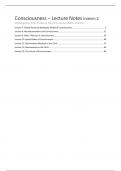College aantekeningen
Consciousness: From Theory to the Clinic - Lecture notes - Interim 2
This summary contains all the information presented on the slides, plus additional notes I took while attending the lecture. Since lecture 7 was one of the least attended lectures, I took extra thorough notes on this lecture.
[Meer zien]





